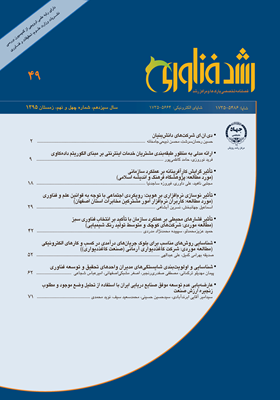تاثیر فشارهای محیطی بر عملکرد سازمان با تاکید بر انتخاب فناوری سبز (مطالعه موردی: شرکت های کوچک و متوسط تولید رنگ شیمیایی)
محورهای موضوعی : Technology Managementحمید عزیزمحمدلو 1 * , سپیده محمدنژاد مدردی 2
1 - دانشگاه بین المللی امام خمینی (ره)
2 - دانشگاه بین المللی امام خمینی (ره)
کلید واژه: فشارهای محیطی عملکرد سازمان انتخاب فناوری سبز شرکت های کو چک و متوسط مدلسازی معادلات ساختاری,
چکیده مقاله :
عملکرد سازمانها یکی از مهمترین معیارها برای ارزیابی موفقیت آنها به شمار می رود. با توجه به اینکه در دهه های اخیر نگرانی ها نسبت به محیط زیست افزایش یافته، شرکت های کوچک و متوسط باید روشهایی به کار گیرند تا عملکرد خود در این حوزه را بهبود بخشند. یکی از این روشها، انتخاب و به کارگیری فناوری سبز می باشد. این مفهوم، در سال های اخیر بسیار گسترش پیدا کرده و سازمان های بسیاری از آن به عنوان استراتژی زیست محیطی استفاده کرده اند. جدید می باشد با توجه به اینکه مهم ترین مساله برای هر سازمان، ارتقای درآمد و سودآوری می باشد، فناوری سبز، با کاهش مصرف انرژی، کاهش اتلاف و افزایش بازده، می تواند گام مهمی در این راستا بردارد. اين پژوهش با هدف بررسي تاثیر فشارهای محیطی بر عملکرد شرکت های کوچک و متوسط با تاکید بر انتخاب فناوری سبز انجام يافته است. داده ها از طریق پرسشنامه و نمونه 75 تایی از مدیران صنایع تولید رنگ شیمیایی جمع آوری شده است. برای آزمون مدل مفهومی از روش مدلسازي معادلات ساختاري بر پایه روش کمترین مربعات جزئی استفاده شده است. نتایج حاصل از این پژوهش نشان می دهد، شرایط کلان بیشترین تاثیر را بر انتخاب فناوری سبز دارد و بهبود عملکرد زیست محیطی منجر به ارتقای عملکرد سازمان می شود. پیش بینی می شود با افزایش فشار شرایط کلان و حمایت دولت، صنایع گرایش بیشتری برای انتخاب فناوری سبز نشان دهند.
Firm performance is one of the most important criteria for evaluating their success . Given the fact that in recent decades concerns about the environment have increased , small and medium - sized enterprises should implement methods to improve their performance in this area. One of the methods is selection and deployment of green technologies . his concept has grown in recent years and many organizations have used it as an environmental strategy. Considering the fact that the most important issue for any organization is to improve revenue and profitability , green technology can take an important step in this direction by reducing energy consumption, waste reduction and increase in efficiency. The purpose of this work is to investigate the effect of environmental pressure on the firm performance with an emphasis on selection of green technology. Data are collected through the questionnaire and 75 samples from managers of small and medium-sized enterprises of chemical paint production . For testing the conceptual model , structural equation modeling based on partial least squares method is used . The results of this research show that pressure of macroeconomic circumstances has the most influence on the selection of the green technology , hence improving the environmental performance leads to growth in firm performance. It is anticipated with increasing the pressure of macroeconomic circumstance and government support , industries have tendency to selection of green technology.
1- رحيمي، نسترن؛ بختيار، محسن، 1385، پروتکل کیوتو، رهیافتها و چالشها، علوم و تکنولوژی محیطزیست، 29.
2- زند حسامی، حسام؛ عالم تبریز، اکبر؛ آشتیانیپور، زینب، 1391، پایاننامه کارشناسیارشد، ارزیابی میزان تأثیر ابعاد توانمندیهای نوآوری تکنولوژی بر ابعاد رقابتپذیری در شرکتهای کوچک و متوسط، مؤسسه آموزش عالی غیردولتی غیرانتفاعی کار.
3- عبدالله میلانی، مهنوش؛ محمودی، علیرضا، (1389)، مالیات زیستمحیطی و اثر تخصیصی آن (مطالعه موردی: فرآوردههای نفتی ایران)، پژوهشنامه مالیات، 8.
4- سازمان صنایع کوچک و شهرکهای صنعتی ایران، آمار شهرکهای صنعتی، http://isipo.ir/.
5- فضلی، صفر، امین افشار، زهرا، (1395)، " بررسی نقش مستقیم محرکهای زنجیره تأمین و نقش تعدیلگری فرهنگ سازمانی در بهبود عملکرد زنجیره تأمین مطالعه موردی: شرکتهای تولیدی استان قزوین"، فصلنامه علمی پژوهشی مطالعات مدیریت صنعتی، 41، 109-136.
6- محمدنژاد، سپیده؛ عزیزمحمدلو، حمید؛ فضلی، صفر، 1395، بررسی تأثیر مالیات سبز بر عملکرد سازمان با تأکید بر ساز و کارهای تکنولوژی سبز و نوآوری سبز (مطالعه موردی: مدیران صنایع شیمیایی شهرک صنعتی اشتهارد)، پایاننامه کارشناسیارشد، دانشگاه بینالمللی امامخمینی (ره).
7- Xia,D., Chen.B., Zheng.Z., (2014). Relationships among circumstance pressure, green technology selection and firm performance. Journal of Cleaner Production.31, 6-23.
8- United Nation,(2008), http://www.un.org/en/index.htm ،
9- Huanga,X-X, Hua, Z-P, Liub,C-S, Yuc,D-J, Yud,L-F, (2015). The relationships between regulatory and customer pressure, green organizational responses, and green innovation performance. Journal of Cleaner Production.
10- Baron, R.A., Tang, J., (2011). The role of entrepreneurs in firm-level innovation: joint effects of positive affect, creativity, and environmental dynamism. J. Bus. Ventur.26 (1), 49-60.
11- Popp, David., (2011), The Role of Technological Change in Green Growth; National Bureau of Economic Research.
12- World Bank,2009, http://www.worldbank.org/.
13- Urda, J., Loch, C.H., (2013). Social preferences and emotions as regulators of behavior in processes. J. Oper. Manag. 31, 6-23.
14- Freeman, R.E., Wicks, C.A., Parmar, B., (2004). Stakeholder theory and “The corporate objective revisited.” Organ. Sci. 15 (3), 364-369.
15- Wagner, M., (2005). How to reconcile environmental and economic performance to improve corporate sustainability: corporate environmental strategies in the European paper industry. Journal of Environmental Management 76 (2), 105-118.
16- kucukoglu, M., Pina,R. (2015). Positive Influences of Green Innovation on Company performance. Social and Behavioral Sciences, 195, 1232 –1237.
17- Apak, Sudi., Atay, Erhan,, (2015). Global competitiveness in the EU through green innovation technologies and knowledge production, Social and Behavioral Sciences 181, 207 – 217.
18- Sen, Suphi., (2015). Corporate Governance, Environmental Regulations,and Technological Change. European Economic Review.
19- Lee, K-H, Min, B, (2015). Green R&D for eco-innovation and its impact on carbon emissions and firm performance Journal of Cleaner Production,1-9.
20- Chiou,T-Y, Chan, H-K, Chung,S-H, (2011). The influence of greening the suppliers and green innovation on environmental performance and competitive advantage in Taiwan. Transportation Research Part E 47, 822–836.

